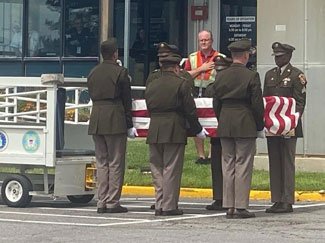Short Changed: Military Comes with Unique Risks for Domestic Violence, Can Silence Survivors
NOVEMBER 30, 2023 | ANNE MARSHALL-CHALMERS and SONNER KEHRT
This article is part of Short Changed, a series looking at the noncombat deaths of women going back to 9/11.

On the night of Aug. 5, Meredith Barney and her daughter, Saria Hildabrand, eagerly planned Barney’s trip from her home in Utah up to Alaska at the end of the month to celebrate Barney’s 40th birthday.
Barney, who gave birth to Saria a few days after she turned 18, said the two “grew up together” and were as close as best friends. She took Saria to her first drag show, and when Saria turned 18, they inked their ribs with matching lucky cat tattoos. Now living apart, they called, texted, or FaceTimed nearly every day.
Before they got off the phone that night, Saria said she was going out for her husband’s 21st birthday. The couple had met in Army basic training, and in 2022, Zarrius Hildabrand was sent to Joint Base Elmendorf-Richardson, Alaska, with the 2nd Infantry Brigade Combat Team. Saria moved to be with him in Anchorage this past winter and joined the Alaska National Guard as a combat medic.

Saria Hildabrand poses with her mother, Meredith Barney. Photo courtesy of Meredith Barney.
They lived in a tidy apartment complex—an American flag out front—near a park and baseball field. For Zarrius’ birthday, they planned to party at Dave and Buster’s, where they were determined to win a large “Pickle Rick” stuffed toy.
Barney had met Zarrius only once, at Christmas, she told The War Horse. He was nice, a bit awkward—like many 20-year-olds fumbling through early adulthood, she said. And it was clear that Saria, a laid-back 21-year-old with striking hazel eyes and a bright, wide smile, was in love.
Still, Barney wanted to privately check in with her daughter during her upcoming visit. “I was going to pull her aside and talk to her in person,” Barney said. “Like, ‘How’s it going? How’s it being married?’”
She never got the chance.
On Aug. 7, Zarrius called Barney. Saria was missing, he said. She disappeared walking to work the day after his birthday.
Days later, an Anchorage police officer found Saria’s body near the couple’s apartment, stuffed into a storm drain underneath a pillow. She appeared to have a gunshot wound to her left temple. By Aug. 18, Zarrius had been charged with her murder.
As The War Horse researched the noncombat deaths of military women since 9/11, Saria Hildabrand’s death emerged as one of many instances of murder by fellow soldiers, typically a current or former intimate partner.
In 2021, Army Cpl. Nakealon Keunte Mosley was charged with shooting and killing the mother of his child, Sgt. Francine Martinez, outside a nightclub near Fort Hood (now Fort Cavazos) two weeks after Martinez filed for child support. Shane Walker, a member of the Air National Guard, pleaded guilty in September to killing fellow guardsman and the mother of his two young children, Alla Ausheva, and setting a fire in their home in 2019. When the bodies of the children were found it appeared they died by drowning. In 2018, Marine Cpl. Rodolfo Rivera was arrested after he told police he may have killed his wife, Lance Cpl. Natasha Rivera—who had been beaten and strangled—in a hotel room after returning from the Marine Corps Ball. The list goes on.
Casey Taft, a researcher and staff psychologist at the National Center for PTSD in the VA Boston Healthcare System, said there hasn’t been a comprehensive study of domestic violence rates in the military for decades, but “from data that’s out there, rates are fairly similar between military and civilian populations,” he said. In the United States, one in three women and one in four men have experienced physical violence from an intimate partner.
A War Horse review of military women’s noncombat deaths since 9/11 found at least 30 instances in which domestic violence ended in death. In the military, family readiness groups often ensure that a service member’s chain of command knows their spouse. Commanders have access to service members’ medical records, as well as any military police reports, including for domestic abuse. Despite that oversight, military life can both add to the risk of domestic violence and make victims more hesitant to report it because the military differs from a civilian job in that service members sleep, eat, and deploy with their coworkers, raising the stakes for those thinking about reporting domestic abuse.
Jacquelyn Campbell, a leader in research and advocacy in the field of domestic and intimate partner violence at the Johns Hopkins University School of Nursing, said owning a gun—as about 50% of service members are estimated to—heightens domestic violence risk, as does substance abuse. And research has shown post-traumatic stress can increase the likelihood of violence by three times, and a partner is often the victim, Taft says.
Should a victim of domestic abuse report it, and should the perpetrator’s commander find out, it could lead to that individual losing their job, stability, and benefits, which might unleash even more stress on an already fraught relationship. Campbell explains it this way: If civilians have to think three times before calling the police on their abuser, military spouses “think an extra time” before accessing help, which can allow abuse to linger unreported.
Award-Winning Journalism in Your Inbox
According to the most recent data from the Family Advocacy Program—the Department of Defense office that addresses domestic violence—54% of domestic violence victims in the military are service members, and 84% are younger than 34. Many of them are far from external sources of support, such as friends or family, said Angela Duhon, who runs the Military and Veterans Victim Advocacy Program at NOVA, the National Organization for Victim Assistance.
In the military, the workplace is closely intertwined with the places people live, sleep, seek medical care, and socialize. The community active-duty victims are supposed to turn to for support is the same community that may support their abuser, if that person is also a service member. While service members can report domestic abuse privately, some domestic abuse survivors worry that their command will find out. There’s fear that should command find out, there could be retaliation, Duhon said.
“There could be all kinds of things,” Duhon said. “So it’s more or less not wanting to be, Oh gosh, now I’m the center of attention, and how is this going to affect me?”
‘DOD Is Unable to Assess the Scope of the Alleged Abuse’
Statistics about domestic violence, also referred to as intimate partner violence if the abuse occurs between romantic partners, and abuse within the military likely don’t include all incidents that occur. In 2022, there were 15,479 reports of military domestic abuse to the Family Advocacy Program—up from 14,299 incidents of domestic abuse in 2021—of which 8,307 incidents met the program’s criteria for abuse. Physical abuse accounted for 68% of domestic abuse incidents, while emotional abuse accounted for a little more than one quarter.

Saria Hildabrand with her family’s dog, George. Photo courtesy of Meredith Barney.
On average, domestic violence reports within the military have trended down over the last decade, though reports of violence between romantic, unmarried partners have trended up. But the Family Advocacy Program tracks only current and former partners who were married, lived together, or had a child together, which means the data does not include violence for dating couples. Domestic violence is also notoriously underreported in civilian populations, and Campbell suspects the same goes for the military population, as well.
After a series of high-profile cases of service members killing their partners, the 2000 National Defense Authorization Act mandated, for the first time, data collection on domestic violence incidents reported to military officials. It also established a domestic violence task force within the Defense Department.
Campbell was a member of the task force and said many of the recommendations made in its initial 2001 report were implemented, including improving danger-assessment tools used by those who respond to reports of domestic violence, as well as education for National Domestic Violence Hotline workers on the unique circumstances of military life.
But the task force presented its findings to Congress just as the war on terror began, and the issue fell to the bottom of the priority list. That’s unfortunate, Campbell said, as some of those service members returned from Iraq and Afghanistan with post-traumatic stress, “which exacerbated their use of violence against partners and children.”
While the department did begin collecting data and Congress later held additional hearings, the problem of domestic abuse has not seen as much attention as sexual assault generally. Domestic violence wasn’t a specific crime under the UCMJ until 2018.
And as the 2000 National Defense Authorization Act also mandated that the military track disciplinary actions against abusers in uniform and other data, a 2021 Government Accountability Office report found the military has not been collecting domestic violence data as required by law, leading to a gap in understanding the extent of the problem.
“DOD is unable to assess the scope of alleged abuse and its rate of substantiation,” the report states.
In 2019, a Defense Department Office of the Inspector General report found military law enforcement organizations did not consistently comply with DOD policies when they responded to nonsexual domestic violence incidents. Out of 219 incidents reviewed in the report, 28% of crime scenes were not processed correctly, 68% did not include thorough interviews, and 22% of incidents were never reported to the Family Advocacy Program. The inspector general found more than 42,000 cases of domestic violence from 2015 to 2019.
In one instance, a “commander instructed law enforcement personnel to rely on the victim’s command officials to take follow-up photographs of victims’ injuries, rather than have law enforcement personnel take the photos,” the report states. And some military law enforcement personnel didn’t have the cameras and other equipment needed to collect and preserve evidence.
The logistics of protecting survivors and holding abusers accountable can be daunting. While civilian protective orders apply both on and off base, military protective orders—which are often all active-duty women believe they need—are enforceable only on base. If the service member transfers out of the command, the military protective order ends. Dual-military couples, where both the abuser and the victim are on active duty, can be particularly challenging to navigate.

Saria Hildabrand, whose maiden name was Saria Barney, snaps a photo in her National Guard uniform. Photo courtesy of Meredith Barney.
“Now we have two commands that basically have to come up with some kind of compromise,” Duhon said.
Military women may also not come forward because of perceptions about what victimhood “should” look like.
“I tend to carry myself in a certain way physically,” said Leah Olszewski, an advocate for military domestic violence survivors who was in an abusive relationship with a fellow service member as an officer in the Army National Guard. “I had so many people ask me, ‘Leah, why didn’t you just shoot him?’”
Melissa Dichter, an associate professor at Temple University who has studied the health needs of women veterans, has surveyed and researched domestic violence in military and veteran populations, and said both men and women in the armed services wrestle with the idea of being vulnerable.
“It’s a misunderstanding,” she said, adding that personal strength doesn’t equate to toughing out abuse from a partner. “It doesn’t mean that we’re not deserving of support around dealing with the aftermath of those experiences.”
‘Nobody Said Anymore That It Doesn’t Happen’
To encourage more abuse victims to come forward, the Family Advocacy Program offers “restricted” or confidential reporting, meaning the victim can alert either a health care provider or domestic abuse advocate about the violence, but neither law enforcement nor command will be notified of the case. The person can then receive counseling and other supportive services that may help get the victim out of an unsafe situation.
The approach in the military to domestic violence has improved tremendously over the last two decades, Campbell said.
“Nobody said anymore that it doesn’t happen,” she said. “Nobody said anymore that there should be no consequences. Nobody said anymore that the military police shouldn’t be involved.”
Recently, the Air Force announced it would hire more victim advocates and increase domestic violence education for active-duty airmen.
Taft, the researcher and staff psychologist at the National Center for PTSD in the VA Boston Healthcare System, operates a cognitive-behavioral program that helps intervene when domestic violence occurs, identify how behaviors are learned, and prevent future abuse.
The Strength at Home program has been embedded in more than 150 VA hospitals. While some military installations have implemented the program, Taft said he would like to see the Defense Department better commit to evidence-based treatment that addresses the root causes of domestic violence. It can be difficult, though, since each installation has its own culture and leaders who come and go, “as opposed to the VA system, which is a very integrated health care system,” he said.

The Army Honor Guard meets Saria Hildabrand’s casket as it arrives in Utah. Photo courtesy of Meredith Barney.
To better grasp the extent and severity of domestic violence in the military—and resources that can address it—Congress needs to mandate regular anonymous surveys that allow victims to report abuse without the fear of repercussions, Campbell said, much like how the DOD anonymously surveys for sexual assault in the military—a move that’s heightened the awareness of rampant sexual abuse in the armed forces and their service academies.
Looking back, Barney said sexual assault was her only concern when Saria decided to join the National Guard as a way to pay for college and achieve her goal of a career in nursing. She even talked with her daughter about how to protect herself.
Saria, a lifelong athlete with an independent streak, assured her mom she’d be fine. When she left for basic training, Barney was excited for her, she said. A new adventure awaited her happy, determined kid, she thought.
After her daughter got married in December of 2022, Barney had no reason to believe Saria’s husband was dangerous. But she works as a therapist—often with individuals struggling with addiction and trauma—and she knows, “What we see and who people are do not always align,” she said.
Our Journalism Depends on Your Support
Police have not released a motive in Saria’s death. A spokesperson for the Anchorage police said that prior to Saria going missing, officers never visited their home for any reason, though someone reported a gunshot in the area in the early morning of Aug. 6. When officers cruised by, they saw nothing obvious.
Police later found Saria’s blood soaking the mattress and carpet in the bedroom she shared with her husband, court documents show. Police also confirmed purchases Zarrius made in the days after she went missing: hydrogen peroxide, a new mattress cover, new sheets, a trash can.
On Aug. 18, an Army Honor Guard met Saria’s casket in Utah. A few weeks later, on what would have been Saria’s 22nd birthday, Barney had dinner with Saria’s siblings. As they ate, a dragonfly perched itself on the window near their table, peaceful and still, as if it belonged, offering an unexpected whisper of comfort.
For a moment, Barney said, her family felt complete.
This War Horse investigation was reported by Anne Marshall-Chalmers and Sonner Kehrt, edited by Kelly Kennedy, fact-checked by Jess Rohan, and copy-edited by Mitchell Hansen-Dewar. Abbie Bennett wrote the headlines. Prepublication review was completed by BakerHostetler.





Comments are closed.